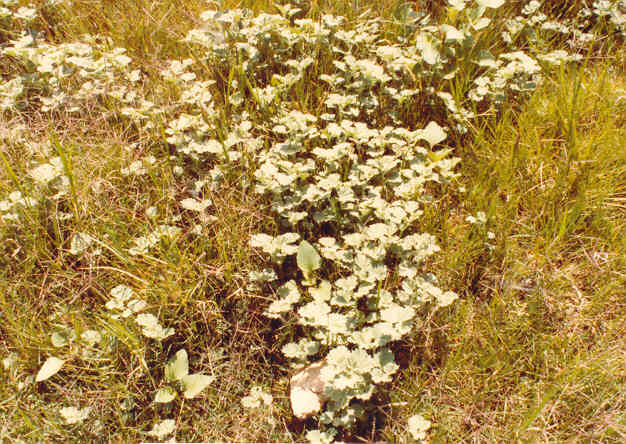
Malvella leprosa (Ortega) Krapov.
=Sida leprosa var. hederacea
 |
Malvella leprosa (Ortega) Krapov.=Sida leprosa var. hederacea
MalvaceaeMallow FamilyNativeAlkali-MallowWhite-Weed |
June Photo
Plant Characteristics:
Low, scurfy, whitish, perennial herb; stems from elongate rootstocks, decumbent
or prostrate, 1-4 dm. long; lvs. round-reniform to broadly deltoid, dentate,
rounded at apex, 1.5-4.5 cm. wide, on petioles 1-3 cm. long; calyx 5-lobed, 6-7
mm. long; petals 5, yellowish, 10-12 mm. long; carpels 6-10, indehiscent,
reticulate on sides.
Habitat:
Moist +/- saline places, below 6000 ft.; many Plant Communities; widely
distributed in Calif.; to Wash., Okla., Mex.
May-Oct.
Name:
Greek and Latin, Malvella, small mallow. (Hickman,
Ed. 754). Sida,
unexplained Greek name of some plant. (Munz,
Flora So. Calif. 569.
Latin, leprosus, scurfy. (Jaeger
139).
General:
Uncommon in the study area, having been found only three times-twice-on
the Santa Ana Heights flats and once on the 23rd St. flats.
Photographs were taken in Santa Ana Heights. In each place there is a
significant colony of the plant. (my comments).
In certain sections of the San Joaquin Valley this plant has become a
serious pest in grain and cotton fields. (Robbins
et al. 299). The larvae of the Painted Lady butterfly, Vanessa
cardui, feed on mallow, lupine, thistle and nettle plants. (No author, sbnature,
A Journal of the Santa Barbara Museum of Natural History, Spring 2004/Vol.
2, No. 1, 6-8). About 150
species of warmer parts of the world. (Munz,
Flora So. Calif. 569).
Toxic to sheep, perhaps other livestock. (Hickman, Ed. 754).
Text Ref:
Hickman, Ed. 754; Munz, Flora So.
Calif. 569; Roberts 28.
Photo Ref:
June 6 83 # 12,13; July 3 83 # 9.
Identity: by R. De Ruff.
First found: June 1983.
Computer Ref: Plant Data 114.
Have plant specimen.
Last edit 10/14/04.
 |
June Photo